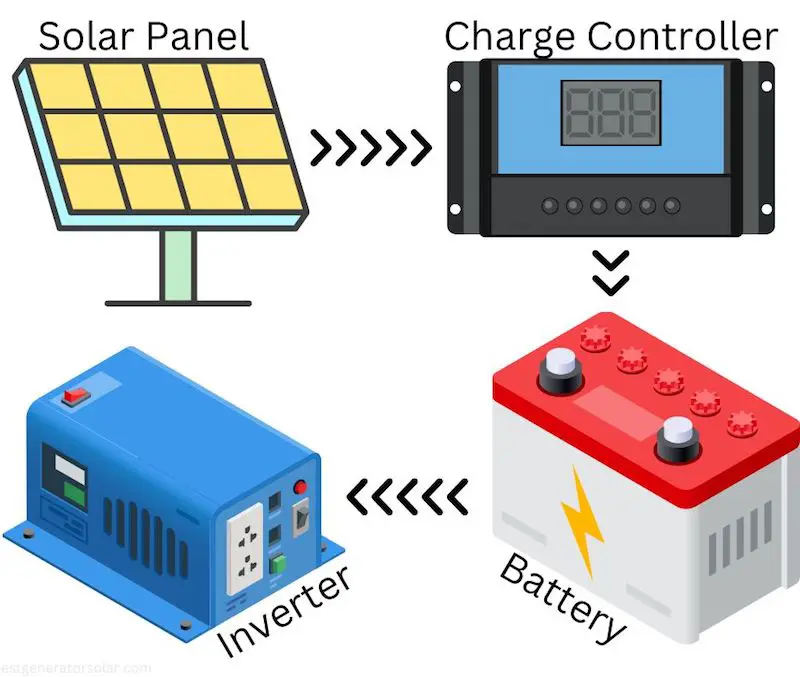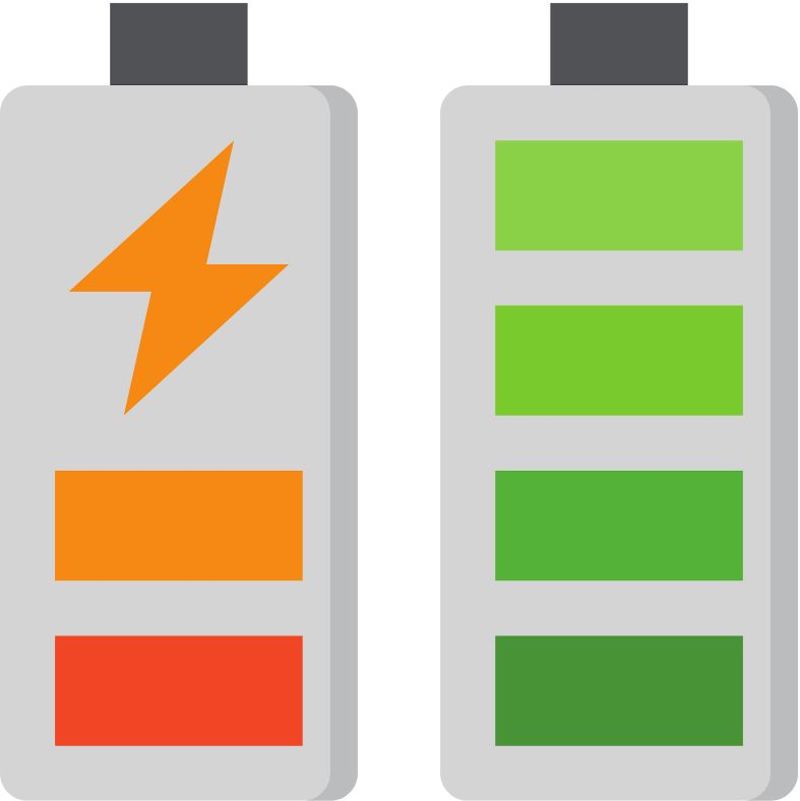If you’re considering going off the grid with solar power, you’ll want to know how much energy storage you need.
Without sufficient battery storage, you could risk running out of power early in the day.
On the other hand, you don’t want to overextend and waste money on a solar backup system with too many batteries.
Depending on your power consumption, you’ll typically need anywhere from 5-15kWh of batteries to live sufficiently off the grid with solar. The recharging rate of your solar generator can also affect its ability to be used consistently off the grid.
Whether you’re interested in being self-sufficient in power outages or you want to be 100% self-sustaining without any reliance on a utility company, read on to learn how to calculate the battery capacity you’ll need for your off-grid solar system.
Off-Grid Solar – How It Works

The following components are essential for off-grid solar power:
- Solar panels: Solar panels simply absorb the sun’s energy before transferring it to the charge controller.
- Charge controller: Regulates the amount of power being delivered to the batteries from the solar panels.
- Batteries: Batteries store the energy gathered from solar panels to be used as needed while off the grid.
- Inverter: Converts DC (direct current) power from the battery or batteries to AC (alternating current) power for consumption by appliances and other AC-powered electronics.
From this quick overview, you can see that the number (and type) of batteries used in your solar system are critical to ensuring consistent power delivery over time.
Let’s take a look at what you can do to find out the size and quantity of batteries you’ll need for sufficient off-grid living.
Data Needed to Calculate Batteries Needed

There are five steps involved in determining the number of batteries needed for an off-grid solar system:
- Determine Daily Total Power Usage
- Determine Days of Autonomy
- Determine Depth of Discharge
- Determine System Voltage
- Determine the Correct Battery Size
Let’s dive deeper into each one.
Determine Daily Total Power Usage

First, determine how much power you’re going to use. Note the watts used for all the appliances you’re going to power.
For example, if you expect to be running a 40-watt appliance for five hours a day, that appliance will use 200 watt hours. You’ll want to do this calculation for all the appliances you anticipate using.
Look up the power consumption for each appliance you want to power. For example:
- A typical coffee maker consumes about 1,000 watts
- A space heater requires about 1,500 watts
- The average laptop charges at around 65 watts
These appliances/devices run for various time periods throughout the average day, so it’s best to estimate the number of hours you’ll use them.
Now you have both the wattage of each appliance as well as the hours of use per day. Below is another example of this for a better visual.
| Appliance | Rated wattage (W) | Hours of use | Daily power consumption (watt-hours or Wh) |
|---|---|---|---|
| Refrigerator | 80W | 24 | 1,920Wh |
| LED TV | 60W | 2 | 120Wh |
| Laptop charger | 65W | 3 | 195Wh |
| Lights (5x 20W bulbs) | 100W | 6 | 600Wh |
| – | – | – | Total: 2,835Wh (2.8kWh) |
In the above example, just under 3,000Wh are needed to power these appliances for a single day. This is the same as three kilowatt-hours (kWh).
Now you have a base for calculating how many batteries you’ll need for your setup.
For a general estimate of how much battery power you may need, you can plug your power consumption numbers into a battery-estimate calculator tool found on Unbound Solar’s website.
You’ll need your monthly estimated consumption, so you can multiply your daily kilowatt-hour usage by 30 days.
Unbound Solar’s tool gives you a basic estimate of what you’ll need, but I’ll share a couple more calculators later on that are more advanced.
Determine Days of Autonomy (“Backup Days”)

How many consecutive days do you expect your system to run without charging? This is mainly to help you keep your system running even in cloudy weather.
Solar panels can charge your batteries even with cloud cover, but they won’t be nearly as efficient.
If you reside in an area that often has cloudy days, you may want to get more batteries to offset the days when solar charging is slow.
If you’re building an off-grid solar system in a new location, you can research climate data here for your area.
Determine Depth of Discharge

This is where the type of battery you select comes into play.
Depth of discharge is how much energy can be discharged from the battery before it needs to be recharged.
If you have a lithium-ion battery, for example, that will typically have an 80% depth of discharge.
So it can discharge 80% of its stored energy before needing to be recharged.
You should also account for an “annual correction factor” because batteries don’t hold the same amount of power over time.
For more information on correction factors, check out this detailed PDF from Oregon State (warning – it’s data-heavy!).
Determine System Voltage
Find out what the voltage is of the system you’re powering – usually 12, 24, or 48 volts. (Here’s a reference with more details.)
Batteries have different voltages because they can work more efficiently depending on your intended use. For off-grid solar systems, your charge controller and solar panels need to be properly sized and arranged to accommodate your batteries’ voltage.
Determine the Correct Battery Size
One of the easiest ways to do this is by using battery bank calculators provided by several battery dealer sites.
With this approach, you can quickly test out different combinations to reach your optimum solar battery installation. For starters, try the solar battery calculators found on these sites:
Once you’ve calculated the solar battery capacity you need (noted as Amperes per hour or “Ah”), then you can determine the number of batteries required.
Batteries will have the type and capacity noted on the outside – for example, “Non-spillable battery – Sealed Lead Acid – 12V, 200Ah.”
So, if the capacity needed is 600Ah, then you know you’ll need three of these batteries.
Here’s an example of a formula that can be used:
“Batteries needed (Ah) = Daily consumption (Ah) * Backup days * Annual correction factor 1.15 / DOD (%)”
Sunmaster Lighting Co. Ltd.
For example, if you need 200Ah daily with two days of backup time and you’re using a battery that has a depth of discharge of 80%, then this is how it would look when calculating:
200 x 2 x 1.15/0.8 = 575Ah
With this example, the batteries needed should total about 600Ah.
Options for Off-Grid Solar Batteries
Calculating the number of batteries you need for off-grid solar varies with the type of battery you choose.
These are the three types of batteries used in most solar systems today:
- Flooded Lead-Acid
- Sealed Lead-Acid
- Lithium-Ion
Flooded Lead-Acid (FLA) Batteries
These used to be the most common type of batteries for off-grid systems.
They’re inexpensive, safe, and reliable.
However, these batteries are large and heavy, and, because they’re wet-cell batteries, they do require maintenance by re-topping off the water in the cells (they also need to stay upright).
Sealed Lead-Acid (SLA) Batteries
These batteries typically hold a charge for a longer period than FLA batteries and are more resistant to temperature changes.
They also weigh less and don’t require much maintenance given they’re sealed. The drawback is that they are more expensive than FLA batteries.
Lithium-Ion Batteries
These batteries are increasingly popular – they’re also lightweight, efficient, and have long lifespans. Of course, the tradeoff is that this is the most expensive choice.
Here’s a table summarizing the attributes of these three types of batteries:
| Battery Type | Cost | Lifespan | Maintenance |
| Flooded Lead-Acid (FLA) | Low | 5-8 years | Yes |
| Sealed Lead-Acid (SLA) | Moderate | 4-6 years | No |
| Lithium-Ion | High | 10+ years | No |
Deep vs. Shallow Cycle Batteries
You may wonder what’s different between these and your car battery. Car batteries are designed to give the quick burst of power needed for ignition.
Batteries for solar systems are called “deep cycle” because although they provide less current at once, they provide continuous current over a long period of time.
Popular Off-Grid Batteries
The following are some of the most popular and highly rated off-grid solar batteries we could find on Amazon:
- CHINS 12V 300Ah Lithium Iron Phosphate Battery
- WindyNation 100AH 12V AGM Deep Cycle SLA Battery
- Mighty Max Battery 12V 100Ah
Closing Thoughts on Batteries & Off-Grid Solar
Remember that several variables can affect the number of batteries you need.
For example:
- Temperature fluctuations affect battery power
- People use more power at different points during the year
- The sun produces more power in summer than in winter
All in all, it’s a good idea to check with an expert when setting up your off-grid battery bank.
Once you’ve installed the correct number of batteries to meet your power needs, take a moment to remember that off-grid power opens possibilities for living in remote areas and can power your home independently of an energy company.
For more detailed information on the entire setup of an off-grid solar generator (inverter, solar panels, batteries, charge controllers, etc.), check out my complete guide here.
